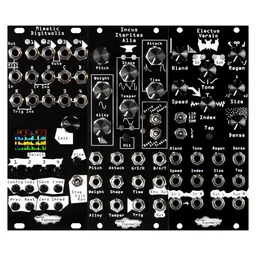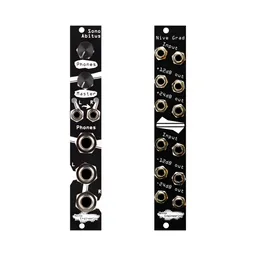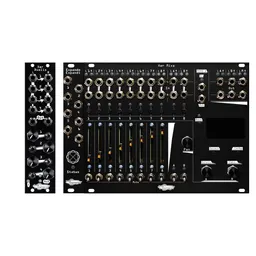We’ve covered a lot of ground on this blog, but if you’re new to synths, you probably have a really reasonable question: what is a modular synthesizer? If you’ve researched synthesizers at all (or even just seen pictures of electronic artist’s studios) you’ve probably seen a modular synthesizer. They’re distinctive and definitely have a mystique about them. But what are they? Today, we’ll try to demystify those giant cable-ridden things and talk about what they actually do and what they’re good for.
But first, here’s what we WON’T be talking about
We’ll be talking in broad brushstrokes about basic concepts today. We’ll also only be talking about Eurorack-format modules: while there are lots of other formats, like 5U, Buchla, and Serge, Eurorack is the most popular format at the moment and it’s where most of our products live. If you’re looking to plan out a system or learn some new techniques, we have some other posts that’ll be more helpful for you. If you just want a basic overview of what the heck all this is, read on!
The Arturia Minibrute 2, a semi-modular synth.
First, the in-between: What’s a SEMI-modular synth?
You may have come across synthesizers that’re referred to as “semi-modular.” Generally, this will be a sort of in-between product that bridges the gap between a normal synthesizer and a modular system: it’ll have patch points (places you can connect things with cables) that are compatible with modules, but it’ll be a complete synthesizer by itself, too, with all the components you need to make a full synth voice. A great example of this is the Arturia Minibrute 2: it’s a full synth, but it has a big patch bay at the top right. It can be patched to itself or connected to Eurorack modules to extend its functionality.

If you like synthesizers, but don’t want to dive into a fully modular system just yet, these can be a great choice.
Okay, what’s the difference between a traditional synth, a semi-modular synth, and a modular synth?
In a nutshell:A traditional synthesizer is prewired with a defined set of components. There are no patchpoints and what you see is sort of what you get. A semi-modular synth is prewired, but also allows the user to patch into a few spots giving a bit of flexibility. A modular synthesizer forces the user to choose each component and then connect them in a pattern that the user desires.
Ok, let’s expand on that a bit.A traditional synthesizer comes with all the pieces inside it, and all the connections pre-soldered together. Firmware updates may change the sound of a digital synth (yes, hardware synths can be digital), but in essence, that synth is what it is. It may have the perfect oscillator sounds in it, but maybe you don’t like the filters it comes with. With a traditional synthesizer, you can’t swap out components, so you’re looking for one that meets all your requirements in one box. A semi-modular synth gives you a complete synthesizer, but lets you interrupt some of those pre-made connections, or make completely new connections, to create new sounds. There’s a bit more flexibility here, so if you like certain components of a semi-modular synth, but not others, you may be able to work around them.Modular synthesizers completely break up a synthesizer into its individual components. To assemble a modular synth, you’ll buy an enclosure/power supply and some number of modules (like filters and oscillators). The signal flow isn’t preordained by the engineers who built the synth, but is created by you with patch cables, and you can change it anytime you want. There are advantages to having a modular system. First, the flexibility of use: most modules have a plethora of inputs and outputs that can be patched together in any number of ways. This can open up new ways of creating and manipulating sounds that wouldn’t be possible on a traditional synthesizer. Second, the amount of versatility: say you like filters that sound like they’re from the 70s, but you also like modern-sounding digital oscillators. That’s not a problem in modular: buy a vintage-inspired filter module and a contemporary digital oscillator and you have exactly what you want from your synthesizer. And if your tastes change, swap out a single piece and have pretty much a whole new instrument. With thousands of modules made by hundreds of manufacturers, there are a ton of choices.
Voltage

Modular synthesizers communicate with voltage, carried from module to module by patch cables. (Yes, this is safe!) This means that control signals and audio signals are the same thing. This adds a lot of flexibility! You can, for instance, use an oscillator to modulate a parameter much faster than a normal control signal would. This can create entirely new sounds, and is a great example of how modular synths can be used in creative ways to make sounds that are difficult to produce with a normal synthesizer.
So are all modules the same?
It depends on what you mean by the same. There are lots and lots of different types of modules that you’ll find in a Eurorack system, like oscillators, filters, VCAs, mixers, envelope generators, sequencers, and more (and more, and more; there are a LOT of different Eurorack modules!). And while there are lots of differences, there are a lot of things that are (at least reasonably) standardized across Eurorack. Modules in this format are three rack units tall (referred to as 3U), and their width is measured in HP (horizontal pitch). The smallest modules you’ll usually find are 2 HP wide, and some can be 40 HP or larger.

Modules that deal with pitch (like oscillators and sequencers) generally follow a 1v/8va—or one volt per octave—standard. What’s this mean? Say we have a sequencer controlling an oscillator, with the sequencer’s voltage output going to the pitch input on an oscillator. Every time the sequencer’s output increases by one volt, the oscillator’s pitch will increase by one octave. Eurorack modules all use the same power system, too (though there is some variety in how things get plugged in). Also, modules from any two Eurorack manufacturers should work just fine together. If you buy your first case and get 6 modules to go in it, those modules could be from six different manufacturers, and it would be fine! If you decided you liked a single manufacturer’s products, there’s nothing wrong with creating a case of just their products, too. Mix and match, or don’t: it all works together!
The downsides of modular: cost and complications
There are two major downsides of building a modular system. First, the cost: creating a modular synth from scratch will often cost quite a bit more than buying an equivalent synthesizer out of the box. Let’s look at a relatively basic synthesizer like the Roland Boutique JU-06A, a recreation of their famous Juno 60. It retails for around $400. But creating a system like that in Eurorack would probably cost about three times that much at the minimum: you’ll need a case, a sequencer, an oscillator, an LFO, an envelope, a filter, and a VCA. Is it worth it? Maybe! I really enjoy patching together voices in my system, and the flexibility that it offers makes it worth it to me. And there’s a lot to be said for the tactile feeling of patching after being in a DAW all day. However, I really enjoy just using my Analog Four sometimes, too: it’s less flexible than a Eurorack system, but it’s really simple to just sit down and make some music. That brings us to our second modular downside: how complicated it can be to use. A single voice in Eurorack will often consist of 5 or more modules which need to be patched together in order to work. If all you want to do is record a quick bassline, that can be a lot of prep to get a simple sound going.
Ameliorating the downsides: are modular synthesizers for me?
Are you watching people with walls of modular synths on YouTube and thinking you can’t possibly afford that? You’re probably right (or if you can afford that, get in touch...we are happy to help!). Seriously, you’re put off by the cost, it’s a real concern, but keep in mind that it’s possible to start small. You don’t need a huge system to get some nifty sounds going. Start by figuring out what your goal is with modular. What do you hope to achieve? Then get informed. Watch videos, ask questions. Talk to your favorite modular shop or manufacturer and get information on products. Then make your purchase. Are you intimidated by the patching? Here is Kris’ Top Secret Guide to Learning Modular: Step 1. Plug shit in. 2. Repeat.You won’t break it and at worst, you’ll make a sound you don’t like. Unplug it and try something else! In time, you’ll get so familiar with your system that all that patching that you have to do to get a bassline going is done in the blink of an eye. Modular may not be your cup of tea, but maybe it is. There’s a heckin’ cool community on Instagram and Youtube if you decide to join our ranks! Still have questions? Drop us a line.






